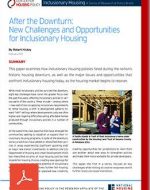Affordable Housing Requirements
If affordable housing requirements are set too high, the concern is that developers may not be able to make sufficient profits, and they will choose not to build or to build in another community with fewer requirements.
Because landowners obviously can’t move to another community, they will have to lower land prices to attract developers – meaning that landowners are the ones whose profits ultimately drop. If land prices fall too far, landowners may decide not to sell – leading to a decrease in housing production overall. This reduction in the supply of new housing would, over time, increase the cost of housing – exactly the opposite of an inclusionary program’s intended goal.
While there is not much evidence of this outcome occurring at any significant level in real programs,* this is an appropriate concern that plays a central role in the debate whenever any community considers the right level of affordable housing requirements. Most communities address this risk by setting requirements well below the level that might negatively impact the supply of land for housing.
In a number of communities, economic feasibility analyses have been useful in helping policymakers get the details right and to build public support for an inclusionary policy. Typically, this kind of analysis involves staff or consultants researching development economics and demonstrating how much local projects can realistically support the costs associated with provision of affordable housing without adversely affecting construction or housing values.




